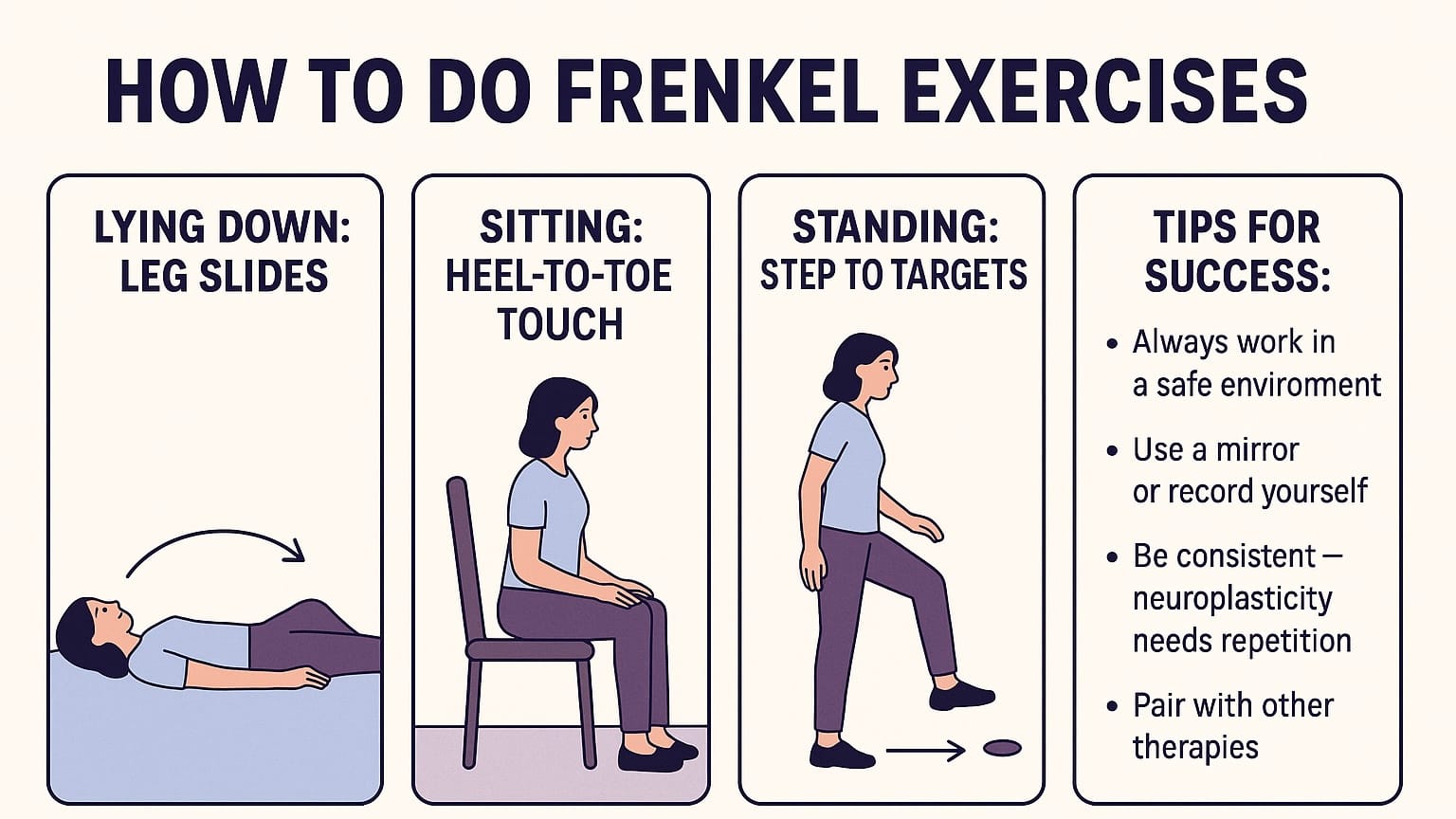When I was first diagnosed with ataxia following lithium-induced cerebellar damage, everything changed. My balance, coordination, speech, or should I say- everything, began to collapse. I immediately started physical therapy, occupational therapy, and speech therapy. But strangely, no one ever mentioned Frenkel Exercises to me.
It wasn’t until early this year — nearly 2.5 years into my recovery — that I stumbled across them. These gentle, repetitive, and deliberate movements were exactly what my brain needed. Not aggressive. Not overwhelming. Just focused practice and most importantly: designed specifically for cerebellar issues and coordination loss.
“Frenkel’s exercise improves sensory and balance recovery among subacute ischemic stroke patients with impaired proprioception and minimal lower limb motor weakness.”
Ko EJ et al., Neurology Asia (2018: 222)
What Are Frenkel Exercises?
Frenkel Exercises were developed by Swiss neurologist Heinrich Frenkel in the late 1800s.
They aim to improve coordination, proprioception, and motor control in patients with neurological disorders, particularly cerebellar ataxia. Rather than building muscle strength, these exercises focus on training the brain to regain control over body movements through conscious repetition and visual feedback. Think of it as teaching your brain to walk, move, and balance all over again.
Since balance and coordination depend on the complex circuitry within the cerebral cortex, cerebellum, basal ganglia, and peripheral motor and sensory pathways … improving afferent disability would be expected to lead to better balance. [Ko EJ et al., Neurology Asia (2018: 222)]
The authors explain: ‘Since balance and coordination depend on the complex circuitry… improving afferent disability would be expected to lead to better balance.’ This highlights how enhancing sensory input directly supports motor control.
But…
A 2025 systematic review by Samir A. et al. showed that while Frenkel’s exercises do significantly improve balance, they “may be less effective than other interventions,” and the wide variation in protocols (from 10‑minute sessions to 36 hours total) suggests a one-size‑fits‑all method doesn’t solve it all.
In practice, I found that combining Frenkel drills with strength training, vestibular exercises, and core stabilization gave me the most consistent improvements, something that’s echoed by the scientific community.
My Experience
Once I started incorporating Frenkel Exercises into my daily routine, I noticed subtle but significant changes:
- My steps became more controlled.
- I stopped swaying as much while walking.
- My brain began to anticipate movement better.
This is the power of neuroplasticity; the brain’s ability to rewire itself through repetition and focused intention. Of course, progress is slow. Ataxia recovery isn’t linear. But Frenkel Exercises have given me a structure to work with; something tangible to support my brain’s recovery process.
But as I said before, combination of exercises worked for me and when it comes to neurorehabilitation, every mindful movement matters.
How to Do Frenkel Exercises
Frenkel Exercises are designed to improve coordination through slow, repetitive, and visually guided movements. The key is to perform each movement consciously, with focus, not speed.
Here are some beginner-friendly examples you can try at home:
Lying Down: Leg Slides
- Lie on your back, legs extended.
- Slowly slide one heel up toward your buttocks, keeping your foot on the surface.
- Then return to the starting position.
- Repeat 10 times, alternating legs.
Watch your leg while moving, this visual feedback helps retrain the brain.
Sitting: Heel-to-Toe Touch
- Sit on a firm chair, feet flat.
- Slowly lift one leg and place your heel on a target (a line or object).
- Slide your foot forward to touch the toe to the same spot.
- Repeat 10 reps per leg.
Standing: Step to Targets
- Stand with support nearby (wall, rail, or chair).
- Place small objects or tape marks on the floor.
- Step one foot onto the target, then back.
- Focus on accuracy, not speed.

Tips for Success:
- Always work in a safe environment.
- Use a mirror or record yourself to engage visual feedback.
- Be consistent — neuroplasticity needs repetition.
- Pair with other therapies like strength, balance, and vestibular exercises for best results.
Frenkel Exercises are not a magic cure but they are a powerful tool in the recovery toolbox. They’ve helped me reconnect with my body, rebuild trust in my movements, and feel more hopeful about the journey ahead.
If you’re on a similar path, I see you. And I hope this gives you something valuable to hold onto.
Resources:





Comments